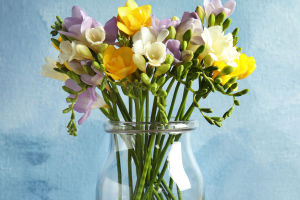Ikebana is an art form that emphasizes the beauty and decorative effect of flowers. Flower arrangement artists create a variety of unique flower artworks by combining different flower materials and utensils, showing the feeling of beauty and aesthetic value.
The art of flower arrangement can also be used as a way of meditation and relaxation, which can help people relax, reduce stress, and improve concentration and creativity. A flower arrangement can help people get close to nature and feel the beauty of life.
There are several different styles of flower arrangements, each with its own unique characteristics and design principles. Here are some of the most common styles:
1. Ikebana: Ikebana is a Japanese style of flower arrangement that emphasizes the use of negative space and asymmetrical designs. It usually features some well-chosen flowers and branches arranged in a minimalist style.
2. English garden: The English garden style is characterized by a loose and natural arrangement, reminiscent of the feeling of an English country garden. It usually contains a variety of different flowers and leaves arranged in a way that looks a little wild and organic.
3. Modern: Modern flower arrangements often feature clean lines and a simple, minimal design. They may contain unusual materials or colors and often emphasize the use of negative space.
4. Formal: Formal flower arrangements are usually more symmetrical and structured than other styles. They often feature a single type of flower arranged in a carefully balanced and precise manner.
5. Contemporary: Contemporary flower arrangements are similar to modern flower arrangements but may include more unusual shapes or materials. They often feature bold colors and unusual textures and may contain elements of abstract art.
6. Oriental style: Oriental style flower arrangements are similar to ikebana, but usually feature more ornate designs and a greater variety of flowers and plants.
7. Cascade: A cascade arrangement features flowers overflowing the rim of a vase or container, creating a dramatic cascading effect. This style is often used for formal occasions like weddings or funerals.
If you want to learn the art of flower arrangement, here are some suggestions for the learning path:
1. Find flower arrangement learning opportunities: You can find flower arrangement classes or workshops at your local florist, flower association, or community center. You can also search online for online flower arrangement courses or instructional videos.
2. Learn the basics of flower arrangement: Before learning flower arrangement, it is very important to understand the basics. Learn the names, characteristics, colors, and sizes of plants, learn about different vessels and tools, and learn some basic flower arrangement techniques and principles of floral design.
3. Practice flower arrangement skills: Practice is the key to learning the art of flower arrangement. You can buy some basic flower materials and utensils, and try to make some simple floral works. Keep improving your skills as you practice and try new tricks and designs.
4. Participate in flower arrangement competitions or exhibitions: Participating in competitions or exhibitions can allow you to better understand the latest trends and techniques in flower arrangement art, and can also provide you with opportunities to display your work and attract more people to appreciate your work.
5. Learn the principles of floral design: Learning the principles of floral design can help you better combine and design floral works. Learn how to choose the right flowers, vessels, and color schemes, and how to use space and line to create balance and beauty.
In conclusion, learning flower arranging requires patience, care, and continuous effort. With practice and learning, you can become a great flower arrangement artist.


